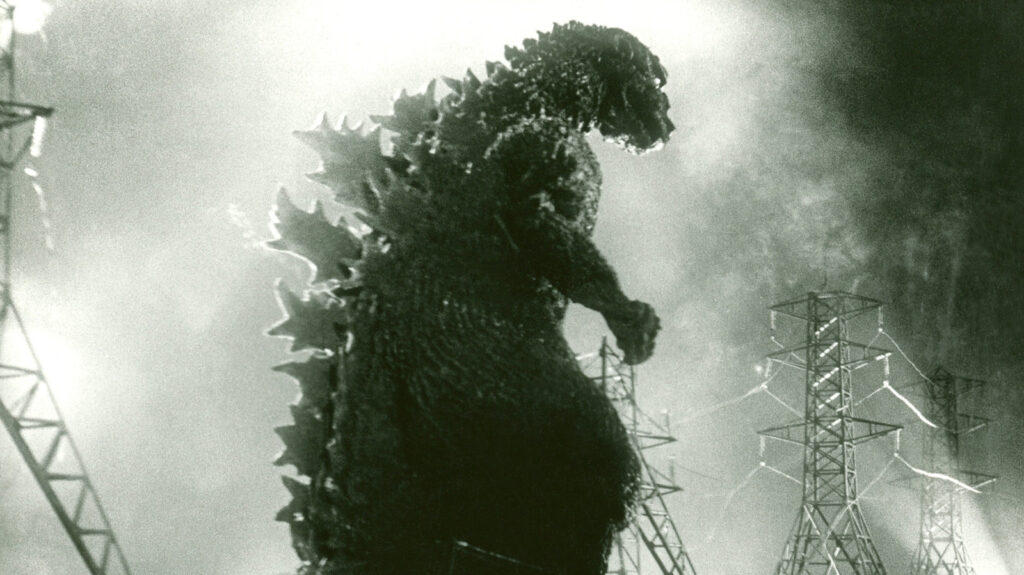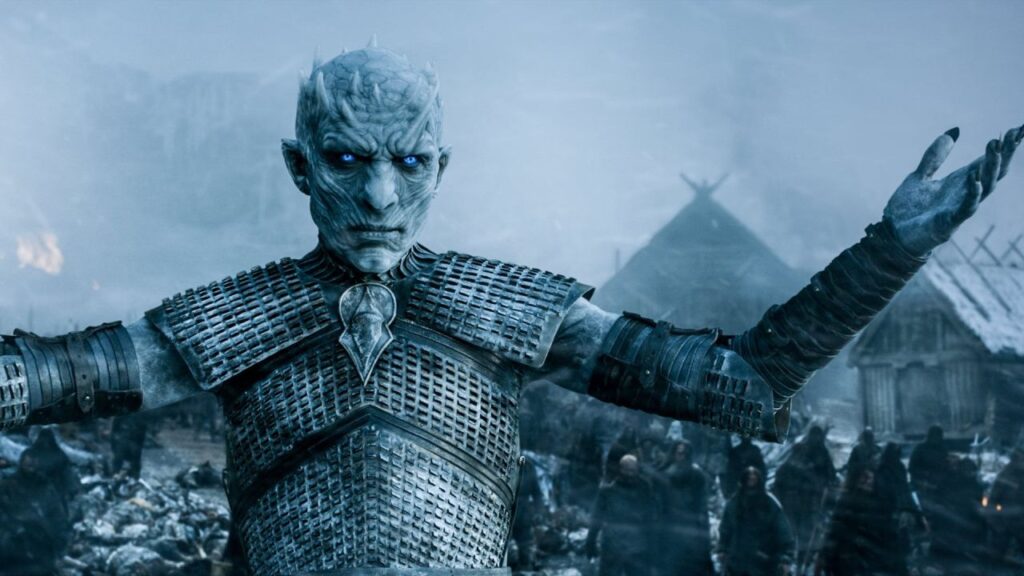![]()
We may receive a commission on purchases made from links.
Few characters in the history of cinema can claim to have been relevant for 70 years, but beginning with the 1954 kaiju classic that started it all, “Godzilla” birthed such a character. Affectionately known as the King of the Monsters, no giant beast that has ever graced the silver screen has made a larger, more lasting impact on the pop culture landscape. But is that title of king appropriate? This is to say, is Godzilla actually a king? Or would Queen of the Monsters be a more apt nickname?
The question of whether Godzilla is male or a female is actually one worth pondering. For English-speaking audiences, we’ve largely come to know the monster as a he. But it’s not so straightforward as all of that. For example, Godzilla has children, which raises gender questions. Minilla, for example, was introduced as the monster’s son in the not-so-great 1967 film “Son of Godzilla,” but it wasn’t explicitly explained how the child came to be.
Did Godzilla lay an egg? Was there a mother? On that same topic, Baby Godzilla from “Godzilla vs. Mechagodzilla II” in the Heisei era of the franchise was adopted. It was technically a dinosaur that the beast, transformed by humans, took in as its own and wasn’t Godzilla’s true child. These moments in the franchise raise questions rather than provide answers.
As such, we’re going to dive deep into the history of the “Godzilla” property and do our very best to provide an actual answer to this question. Spoiler alert: it’s not at all straightforward. So buckle up, because we’re about to get into the weeds.
Originally, Godzilla didn’t technically have a gender
“Godzilla,” aka “Gojira,” directed by Ishiro Honda, was a Japanese production. It was very much made in response to the devastating use of the A-bomb on Hiroshima and Nagasaki during World War II. It’s also a Japanese film that birthed a great many sequels, with the rest of the world, particularly North America, embracing those movies later on. But Godzilla being a Japanese creation is important as it is easier to avoid using gender in the country’s language.
That being the case, in the original Japanese films, Godzilla and all of the other monsters, foes and allies alike, are referred to without gender labels such as “he” or “she.” Japan, however, used gender-neutral pronouns, basically the equivalent of “it.” That’s the first wrinkle. So, where did the “he” come from that led us to label the kaiju as the King of the Monsters? You can largely thank the U.S. for that one.
In the English-dubbed versions of the “Godzilla” films, the character is explicitly described as a male. Why, exactly? Jeffrey Angles, who translated both “Godzilla” and “Godzilla Raids Again,” the first two Showa era of the franchise, for the University of Minnesota Press, has the answer. Angles translated the two novelizations of the films into English for the first time in 2023. In an interview with MovieWeb, he explained why the gendering happening in English translations:
“This particular kaiju doesn’t have any gender, at least in the book, in neither ‘Godzilla’ nor ‘Godzilla Raids Again.’ It’s very, very easy in the Japanese language to avoid gender altogether. This entire book didn’t mention Godzilla’s gender. But in English, it’s hard to avoid. Sometimes I filled in the name Godzilla, sometimes I use the word ‘monster’ to avoid gender, but using those words over and over again would be strange and repetitive, so we need pronouns somewhere in there. And so I thought long and hard about it, and I eventually decided to use ‘he,’ which I think is maybe a potentially controversial decision.”
Toho’s Godzilla was only given a gender thanks to English translations
Angles is speaking largely to his own experience but that certainly translates to writing a script for an English dub. At the least, that helps explain why in the early Showa era films Godzilla became known as a he. However, Angles also revealed that Toho, the Japanese company that controls the “Godzilla” franchise, isn’t necessarily in favor of giving the monster a gender:
“Some people feel very viscerally, like the people at Toho studios feel very strongly that Godzilla is an ‘it’ and not a ‘he’ or ‘she’ or ‘they.’ I kind of give my rationale for that choice in the afterward — [‘Godzilla’ and ‘Godzilla Raids Again’ novelization author Shigeru] Kayama thought about Godzilla as a stand-in for the nuclear bomb, and it was men in America who were developing the hydrogen bombs that frightened Japan so much in 1954. So maybe it’s perhaps not inappropriate to call Godzilla ‘he.'”
Warner Bros. and Legendary agreed with that logic when they created the MonsterVerse, which kicked off in 2014 with director Gareth Edwards’ “Godzilla.” That franchise now includes a total of five movies, with the most recent entry being “Godzilla x Kong: The New Empire.” The MonsterVerse Godzilla is definitively a he and has always been referred to as such on screen. Director Michael Dougherty, who helmed “Godzilla: King of the Monsters,” was asked directly about the gender question in a 2019 interview with Yahoo. His answer was fairly blunt:
“It’s a he, he’s called King of the Monsters.”
The Toho line of thinking that Godzilla is neither a he nor a she and more of a they is supported by certain films in the property. “Godzilla 2000” and others imply that Godzilla reproduces a-sexually, laying an egg at some point to continue on. That’s actually how the franchise continued (without getting into the messy continuity of it all) after the original 1954 “Godzilla” killed off the beast with the Oxygen Destroyer.
There’s also the idea that Godzilla sort of transcends gender by being a literal god of sorts. The tagline for 2016’s dark reinvention of the franchise “Shin Godzilla” was literally, “A God incarnate. A city doomed.” That is also something to consider. It’s not as simple as “boy” or “girl.”
1998’s American Godzilla is an odd exception to the rule
The frustrating answer to the question we started with is that there is no definitive gender one can attach to Godzilla. It depends on the movie we’re talking about, the person we’re talking to about it, and the language a given film is being watched in. Largely, the male gendering has stuck thanks to the popularity of the English translations, but there has been plenty presented over the years to complicate matters (the “god” of it all being perhaps the most complicating factor).
The most interesting exception to any rules that exist came in 1998 when the first ever American version of the franchise came to pass. Director Roland Emmerich’s “Godzilla” may have been a major disappointment at the time, but it also introduced something interesting to the mythos. In the film, it’s revealed that this new version of Godzilla actually produces asexually. Or, to put it another way, only a single parent is needed to produce offspring. The climax of the film sees a massive nest of baby Godzillas getting ready to invade New York City, before they’re blown to smithereens.
This version of the creature, later renamed Zilla, was not exactly popular and was eventually killed off in “Godzilla: Final Wars.” Be that as it may, this notion of the beast being able to reproduce asexually once again muddied the “Is Godzilla a male or female” question. Perhaps Godzilla is a hermaphrodite, which is a being with both male and female reproductive organs. While this movie can’t truly be used to represent the broader “Godzilla” canon, it did help raise an interesting question. It also further proved that this question doesn’t have a black or white answer.
You can grab the original “Godzilla” on 4K or Blu-ray via Amazon.


